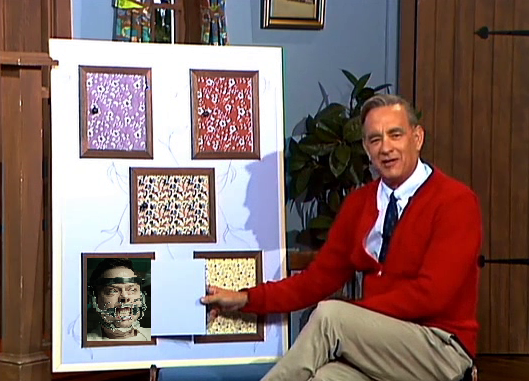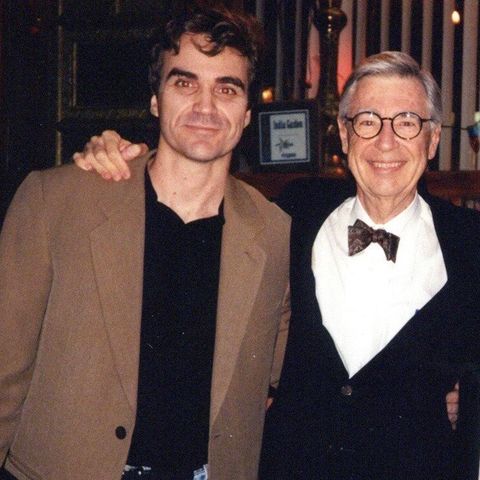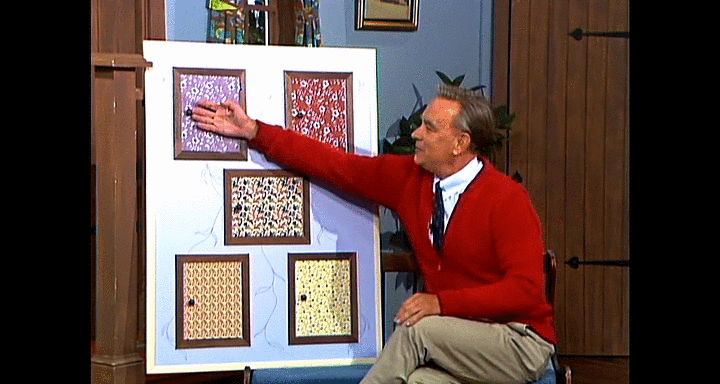
Last year’s Won’t You be my Neighbor? was an emotional tribute to the beloved Mr. Rogers that warmed the hearts of most audiences, and its controversial Oscar snub is something we’ll likely hear about for decades. It wasn’t long until rumors of a Fred Rogers biopic surfaced, with Tom Hanks starring. Thus, A Beautiful Day in the Neighborhood was born. At least, that’s the order of events from a surface perspective.
The screenplay for this film was written prior to 2013, and showed up on the notorious Black List – a large-scale poll of the best-loved unproduced screenplays of the year. This is not a film created as a reaction to the popularity of last year’s Rogers documentary, and it’s important to keep that in mind. Instead, it’s a film that was met with several setbacks, but the success of Won’t You be my Neighbor? created what seemed like an ideal time to unleash this upon the world.
While this movie hasn’t by any means flopped at the box office, I can’t help but feel that the emotional impact of A Beautiful Day in the Neighborhood was stunted a bit by its proximity to the release of the documentary. We’ve already processed how we feel about Fred Rogers, and this time around, it’s going to take a whole lot more than exposing what a wonderful person he was to make us feel anything novel. That’s a tremendous amount of pressure for this release, because now that Fred Rogers is at the forefront of the public’s consciousness as a bona fide hero of children’s entertainment and a Ghandi-esque saint, simply portraying the man’s good deeds isn’t nearly enough. On top of this, general audiences seem to grow more cynical about the Oscar-bait ritual (and the Oscars) by the year, presenting yet another reason for us to ignore the award-hungry elephant in the room.

What makes this history so strange is that A Beautiful Day in the Neighborhood is not a Fred Rogers biopic. Instead, it’s a dramatized story of journalist Tom Junod and how his relationship with Rogers affected his own life. It attempts to capture the essence of Rogers rather than simply telling his story outright, and while that is a somewhat compelling concept, I’m not sure it’s what I (or anyone else) wanted.
I really expected to be bored to death by this, so when I sat down to watch it, I was fully prepared to zone out 20 minutes in and do something else as it played in the background. It took less than 60 seconds for me to re-evaluate those intentions.
The film opens like an episode of Mr. Rogers’ Neighborhood, with Tom Hanks pulling off his sweater and sitting in front of all the nice boys and girls to tell them how special they are. We’re shown a “picture board” with five panels, each with a picture of one of Rogers’ friends. The first three are recognizable characters from the TV show, but the fourth is a picture of a less-recognizable face covered in blood and bruises. This is Lloyd, the real protagonist of this story. We’re told that Lloyd is having trouble with forgiveness.

Let’s ignore the fact that Tom Hanks just gazed into the camera and verbally conveyed the theme of the entire movie, because that’s the least notable aspect of this introduction. Hanks plays this scene like a John Wayne Gacy acolyte, and the way it unfolds just makes his performance even creepier. He goes through his picture board like a serial killer showing off his morbid trophies. The scene moves on after panel four, but from this performance, I gather panel five contains something truly terrifying. From the very beginning, it feels like Rogers is about to jump out of your screen and gently strangle you, stashing your body away where no one will ever find it – because this isn’t his first rodeo. This creature has killed before, and it’s trying to use your nostalgia to lull you in to a false sense of security while feeding that underlying dread you can’t seem to shake – because you taste better when you’re scared.
Sound familiar? It should, because that’s the modus operandi of the titular villain from Stephen King’s It.

By the time Hanks disappears from the story altogether for the next 20 minutes, I was actually grateful not to have to see his unsettling face for a while. That is, until the moment when Lloyd opens his smug, cynical mouth, and it becomes abundantly clear that he’s an Ebenezer Scrooge stand-in who exists solely to demonstrate how Rogers is going to transform him into yet another happy, soulless cog in the machine – or another floating corpse in his personal sewer. To put it bluntly, Lloyd is just a shitty character. He’s obnoxious, obvious, boring, selfish, egotistical, and cynical, and he’s the guy we’re about to follow for two hours. We get to see what an emotional fuck-up Lloyd is over and over again, as he repeats the same mistakes until Rogers steps in with his magic wand of overwhelming kindness.
Lloyd’s boss, like everyone else, is fed up with his behavior (or rather, the negative publicity he seems to leave in his wake.) In order to encourage an attitude adjustment and an image overhaul, she commands him to interview the beloved Fred Rogers. Lloyd protests of course, but is given no other option.
From the beginning, Lloyd is baffled by Rogers, as he should be. He conducts a brief interview on the set of the show, and it becomes very clear that everyone around Fred is protecting him in some way, but is also frustrated by his space-y tendencies that continuously disrupt shooting. Everyone seems rather unamused by Rogers’ good deeds, and it’s as if they’re all guarding a dark secret about him, afraid of what might happen if his wrath is unleashed upon the earth.
After that first interview turns Lloyd’s cynical world upside down, Rogers begins calling him on a more regular basis, slowly insinuating himself into Lloyd’s life. Rogers asks about his wife and child, the bruises on his face from a recent fight, and even the source of his anger toward his father. It all begins to feel like prying very fast, and it certainly isn’t normal behavior. It’s like a home invasion thriller where characters keep their front door propped open at all times.
There’s a point in this screenplay where you begin to realize that this isn’t using style to simply harken back to our nostalgia for the show, and has ambitions beyond being a simple story of forgiveness. Most scene transitions are marked by models of cars and planes moving through a city of miniatures meant to look like the ones in Mr. Rogers’ Neighborhood. When Lloyd is having a particularly difficult time, he enters this world of make-believe. He is transformed into his favorite childhood toy, and is confronted by Daniel Tiger, King Friday the 13th, and a giant-sized Lady Aberlin, who appears as Lloyd’s wife. They cruelly grill him about his emotions until, sobbing, he explains what he’s feeling. Later on, Lloyd is taken by Rogers to a Chinese restaurant, where Rogers essentially STOPS TIME SO THAT LLOYD CAN THINK ABOUT ALL THE PEOPLE WHO HAVE MADE HIS LIFE WONDERFUL OH MY GOD WHAT THE FUCK WHY? Small chunks of this movie play out like a Charlie Kaufman fever dream, and it’s really fucking odd.

I can’t exactly spoil the rest of the plot for you, because you already know how this ends. I suppose I could tell you what’s not behind panel number 5 – a photo of the mangled corpses of Lloyd’s family – simply because I don’t want to get your hopes up. As was “hinted” at in the opening, Lloyd is given a redemption arc, and is taught the value of forgiveness in the most ham-fisted way possible.
A Beautiful Day in the Neighborhood really fucked with me. It took me hours to make up my mind about Tom Hanks’ performance as Fred Rogers, but ultimately, I think he did a wonderful job. This seems to contradict my previous statements, but hear me out.
Children’s entertainment in 2019 is bound to come across as creepy. Like Pennywise, we’ve spent centuries perverting tales of innocence into stories of horror, shock, and unease. Childhood is associated with positive nostalgic emotions, and when we present a version of it that subverts our fondest memories, it becomes terrifying. The duality of innocence in storytelling is so intrinsic to horror (and prevalent) that we hardly regard it as a cliché of the genre – it is simply an effective means of unsettling an audience. We shouldn’t feel bad for jumping to these conclusions either, because our skeptical reactions when presented with things that seem almost too innocent are a natural defense mechanism against danger.
Even during the run of Mr. Rogers’ Neighborhood, adults were on the fence about the man’s strangely calming demeanor. The existence of a man so innocent is uncanny enough that we’ve invented alternative origin stories for him (such as the “Mr. Rogers was a sniper in the war and PTSD made him this way” rumor) because we can’t wrap our minds around how someone could exist in this world and remain unsullied by its wicked, destructive ways.
Go back and watch an episode of the show with your mind turned on and your heart turned off, and you’ll find the same creepy undertones and mannerisms that Hanks displays in this movie. Creepy Fred Rogers is not an invention of this film – he has always existed, inseparable from his legacy. His innocence was notoriously perplexing and off-putting, although generally, in the stories we hear from those who met him in real life, that’s punctuated with, “…until I got to know him.” If Tom Hanks’ performance manages to unnerve me from the start (as we’ve established it probably should), then I suppose it’s a more accurate portrayal than I first gave it credit for. There are even scenes where they seem to be having fun with the creepiness, and I have to respect that.
What I cannot respect is the formulaic A-plot of the film, and more precisely its central character. Lloyd is annoying every second he’s on-screen. Casting Matthew Rhys as the lead and writing his character this way was the most egregious error here. Chris Cooper, who plays Lloyd’s father, puts out a decent performance as a dying man begging for forgiveness from his son. Susan Kelechi Watson is perfectly fine, although just a little wooden, as Lloyd’s wife, even though it’s difficult to see why her character would marry him in the first place. Enrico Colantoni isn’t given much screen time, but he’s able to accurately portray what a working relationship with Rogers was probably like. Really, all of the acting is at least passable, which makes Rhys’s bland performance stand out even more.
In some sense, with such an awful protagonist, the film reverts to what most of us thought we were getting in the first place – a Fred Rogers biopic. Tom Hanks is all that matters about this movie. I can’t give this a ringing endorsement, but there is certainly artistic merit to be found. The screenplay takes some big risks, and while some pay off and some don’t, I can’t help but admire that. Those risks are what keep this movie engaging, and while I’m not thrilled with the overall product, I like Hanks’ performance…just the way it is.
6.5/10